SEAWEED BEACH
Jason Whiffen of Port Jefferson snapped this cool low angle shot of Port Jefferson Harbor at low tide on June 18
Send your Photo of the Week to [email protected]
SEAWEED BEACH
Jason Whiffen of Port Jefferson snapped this cool low angle shot of Port Jefferson Harbor at low tide on June 18
Send your Photo of the Week to [email protected]
The Town of Brookhaven will offer Hula Hooping classes at West Meadow Beach, Trustees Road, Stony Brook this summer. Classes are for beginners or the more experienced “hoopers”! Beginners will learn basic fundamentals to keep the hoop up while spinning and dancing in and out of their hoops. More experienced students will learn some advanced skills and tricks. Enjoy one of the many beautiful beaches in Brookhaven while having fun and burning calories! *Weather permitting*
Classes will be held on Wednesdays, Aug. 3, 10, 17, 24, 31 and Sept. 7 from 6:15 to 7:15 p.m. Fee is $40 per 6-week session. Pre-register by Monday, Aug. 1 by calling 631-363-5193.
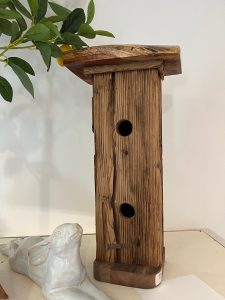
The Reboli Center for Art & History’s July artisan of the month is Chris Kelsch.
Chris Kelsch, born and raised in Stony Brook, creates incredible birdhouses, in a wide range of unique woods. He developed his distinctive style over years of education, experimentation, and adventures.
Chris credits his shop teacher, Dean Jenkins, with inspiring his passion for woodworking. After serving in the military, Chris attended Delhi Technical College where he studied carpentry and woodworking.
After college, Chris joined the team of woodworkers at Tanglewood Conservatories in Maryland where they design and build custom high-end conservatories and greenhouses from exotic hardwoods. His role was to focus on the intricate architectural aspects such as corbels, pilasters and detailed window frames to house the stained glass windows.
His fondness for exotic woods led him to discover a mill in Pennsylvania that provides Martin Guitar with beautiful rare woods. He also found amazing antique barn woods.
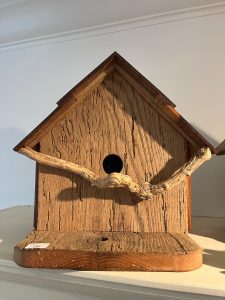
When Chris retired in 2017, he started making bird, bat, butterfly and bee houses. “I enjoy creating safe houses for wildlife,” he explains. I love using rare wood and antique barn wood as they create solid birdhouses. The stability of these woods ensures a solid and quality house. I also appreciate how beautiful grains contrast with the patina of barn wood.” He noted that some of the barn wood he uses is 300 years old.
“I am thrilled to be able to display my work at the Reboli Center,” Chris said. Joe Reboli was a big part of my life as my older brothers were friends with him. In fact, my mother referred to Joe as her ‘other’ son. The Reboli Center is close to my heart, and all involved are beautiful people with a beautiful mission.”
Lois Reboli, president and founder of The Reboli Center said, “I have known Chris a long time and love his work. His birdhouses are so beautiful and unique that it is a pleasure to sell his pieces in the Design Shop and to have him as our July artisan.”
The Reboli center is located at 64 Main Street in Stony Brook and is open Tuesday to Saturday from 11 a.m. to 5 p.m. and on Sunday from 1 p.m. to 5 p.m. Admission is free. For more information, please call 631-751-7707.
The Town of Brookhaven will offer a Sunset Yoga class at Cedar Beach, 244 Harbor Beach Road, Mt. Sinai on Thursdays July 14, 21, 28 from 7 to 8 p.m. and Aug. 4, 11 and 25 from 6 to 7 p.m. This class offers a balanced approach to yoga consisting of physical postures, breathing exercises and relaxation to help restore physical, emotional and mental health and well-being. Wear comfortable clothing and bring a mat, blanket or pillow to sit on. $35 per 6-week session. Pre-register by Tuesday, July 12. Call 631-451-6112 for more information or to register.
Mark your calendars! The New York Marine Rescue Center will host the following beach cleanups for the summer. Join them in their effort to eradicate marine debris from our local beaches and help save our wildlife.
Cleanup’s at the following locations will take place on Sunday’s from 6 to 8 pm.: Cedar Beach, 244 Harbor Beach Road, Mount Sinai on July 10, Aug. 7 and Sept. 18; Crab Meadow Beach, Waterside Avenue, Fort Salonga on July 24, Aug. 21 and Sept. 25; and FINS at Smith Point County Park, 1 William Floyd Parkway, Shirley on July 24, Aug. 21 and Sept. 25.
To participate in one of these cleanup’s, call 631-369-9840 or visit www.nymarinerescue.org.
The Ward Melville Heritage Organization (WMHO) hosted its second Long Island Sound Connections Summit in the first week of June. This virtual, hands-on collaborative learning program connects students across Long Island Sound and allows them to conduct their own experiments to better understand the water systems in their environment.
Long Island Sound Connections is the first program to connect both shores with students from New York and Connecticut – With virtual class check-ins, “summits” where students present their findings, and an ongoing collection of data and that information’s analysis. The Long Island Sound Connections program was designed to help students learn about the Long Island Sound and to inspire them to protect their environment. The program is offered via distance learning from the WMHO’s Erwin J. Ernst Marine Conservation Center (EMCC), students have front row seats to one of the most pristine natural resources in the Northern Hemisphere.
WMHO collaborated with University of Stony Brook Professor Jeffrey Levinton of the Ecology and Evolution Department to develop a system of data collection parameters for monitoring West Meadow Creek’s water quality and species counts. Professor Levinton will continue to support WMHO in developing this multipronged project that seeks to educate the public while providing data representing the creek’s health over time to the public and researchers.
Students performed their own experiments and led their own research on the topics of water salinization, acidity and quality, and human impact on the environment. Students also compared and contrasted their two environments (suburban and urban), and presented it to their partner class. The research collected from both sides of the Long Island Sound has been entered in WHMO’s software. Each season additional data will be added to it to create a map to assist researchers of all ages to understand the similarities and differences and track changes over time.
The second “Summit” of classes in this program was between Michelle Millers’ 6th Grade Science Class from Middle Country School District in Selden, New York, and Victoria Soltis and Angelica Lawrence’s 6th Grade Science from Edison Elementary School in Bridgeport, who worked in collaboration with Mill River Wetland Committee. With grants provided by the Fullwood Foundation, the Frey Family Foundation and Webster Bank, this program was offered to participating classes free of charge. All costs associated with the program were sponsored by these organizations.
Pictured from left are Megan Frey, Frey Family Foundation; Max Frey; Deborah Boudreau, Education Director, WMHO; Gloria Rocchio, President, WMHO; New York State Senator Mario R. Mattera, 2nd Senate District; Dr. Richard Rugen, Chairman, WMHO; Kathleen Mich, Trustee, WMHO. Not shown, Nicole Sarno, Business Manager, Webster Bank and Dr. Robert Parker, The Fullwood Foundation.
For more information about the WMHO, on the Long Island Sound Connection program, other historic, environmental and scientific programs that the WMHO offers, please call 631-751-2244 or visit wmho.org.
By John L. Turner
Throughout the forests, woodlands, and wetlands of Long Island exists a group of plants with great lineage and I do mean GREAT lineage, with a fossil record that goes back approximately 360 million of years, well before the appearance of dinosaurs. In some places in the world, but not Long Island, these species reach tree size. Dozens of examples of this group can be found here, perhaps one or a few in an untouched section of your yard. What group might this be? Ferns and their relatives — the clubmosses and horsetails (the latter two will be the subject of a future article).
Because they aren’t colorful, ferns are often thought of as “background plants” in landscape settings. But that doesn’t mean they aren’t beautiful because many are very much so, given their fragile, graceful, and lacy appearances. Generally you can think of a fern frond as being “undivided, once-divided, twice-divided, or thrice-divided,” the lacier a fern the more “cuts” or divisions it has. (We don’t have any undivided ferns native to Long Island).
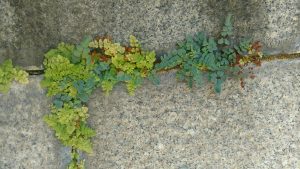
Remembering how many times a fern is divided is a convenient way to classify and identify species (it’s how I learned it many decades ago). So a fern like the well-known Christmas Fern, is a “once-divided fern” since its one division creates just a series of leaflets that collectively make up its frond surface. A twice-divided fern, like Bracken Fern, has leaflets like the Christmas Fern but in the Bracken Fern’s case, the leaflets themselves have cuts, creating subleaflets or pinnules. If, in turn, the subleaflets are cut to form even smaller lobes, as in Hayscented Fern, you’re looking at a thrice-divided fern.
Ferns have no flowers — no nectar, pollen, or seeds and depend upon no insects or animals to successfully reproduce. Rather, they depend upon spores and vegetative spread (through rhizomes in most cases but also, as in the case of Walking Fern, an undivided species that doesn’t grow on Long Island, in which the fern tip arches downward to anchor in the soil from which another fern grows, hence the term “walking”).
The tiny, almost microscopic, spores develop within a case known as a sporangia. Often the sporangia are clustered together in what are known as sori or fruit-dots (although this isn’t accurate). The location of the sori can be very helpful, in fact diagnostic, in identifying fern species. With some, such as Sensitive, Cinnamon, and Netted Chain Ferns, the sori are located on a separate stalk, while in others like Grape Ferns they are connected via a stalk to the main frond. Most often though, the sori are located on the underside of the frond leaflets and their shape and location on the leaflet can be diagnostic as to species. A five to seven power hand lens opens up a new world to you while inspecting the many distinctive spore cases produced by our native ferns.
You might reasonably assume that a spore, wafting away from a sporangia upon the slightest breeze, will eventually land in a suitable location, germinate, and develop into a new fern. Your assumption, while most reasonable, would be incorrect as the process is more complicated and this is where the concept of “alternation of generations” comes in. The spore does germinate and develop, but not directly into a new fern. Rather, it grows into a prothallus, a small structure shaped like a Valentine’s Day heart. The prothallus is the “gametophyte” stage because the prothallus contains the gametes or sex cells (sperm and egg) On one part of the “heart” is the antheridia, where the sperm come from, and nearby is the archegonia, which produces the egg. In optimal conditions, that is, when the prothallus is wet, the sperm travels the short distance to the egg. Upon germination a new spore-producing fern (the sporophyte stage) develops. The sporophyte is the fern stage that is before your eyes to identify and enjoy. So we have sporophyte-gametophyte-sporophyte-gametophyte, ad infinitum.
As mentioned, some ferns spread vegetatively through the growth of underground horizontally oriented rhizomes from which new fronds grow in a perpendicular fashion, emerging from the surface of the soil. Bracken Fern, the common fern species of the drier upland habitats in the Pine Barrens, is an excellent example of a fern that spreads through rhizomes. In some places bracken fern stands can cover as much as an acre or more.
Long Island is home to several dozen fern species, present in most habitats occurring here. Freshwater and forest habitats are especially well represented with ferns; however, none occur in salt marshes or on beach dunes. Let’s look at some!
The previously mentioned Christmas Fern is a common and widespread species growing throughout Long Island’s woodlands. It is often noted the species received its name from the similarity of a leaflet to a Christmas stocking hanging from a fireplace mantle. A competing explanation is that this fern species is one of the few plants still green through the winter, standing out around Christmas time.
Similar looking to Christmas Fern but smaller is the Common Polypody, so named due to the resemblance of the leaflets to lobed feet (think pody-podiatrist). This fern is uncommon here, growing on steep slopes and large boulders. This species was a favorite of Henry David Thoreau who on several occasions remarked about the “cheerful communities” of polypody growing on rocks in New England.
Sensitive Fern grows in more sunlit locations and is easy to identify, with a “once-divided” look. As mentioned above, the sporangia are on separate stalks growing from the rootstock. Come the fall and frost, Sensitive Fern quickly dies back, hence its name.
Cinnamon Fern is an abundant fern growing in moist woodlands and wooded swamps. It is quite distinctive with a beautiful growth form in which several sterile fronds radiate from a central rootstock with the spore-producing fronds coming up through the middle. The sterile fronds appear as unfurling fiddleheads (there are no species of ferns known as fiddleheads per se; a fiddlehead is a growth stage of some ferns in which the emerging frond at first is curled like the head of a fiddle; in some species, the fiddleheads are edible). They are coated in a cinnamon “wool” — giving rise to the common name — which is reportedly used by hummingbirds and a few songbirds as nest lining material.
Bracken Fern is, as mentioned earlier, locally common to abundant in the Pine Barrens, forming an extensive thigh-high layer, unmistakable due to its triangular growth form. Bracken Fern is one of the more widespread species of ferns, found in many other places in the world including Japan and Asia. While it spreads mostly vegetatively, it also produces spores located on the rolled margins of the leaflets. It was once harvested for food but this came to an end when the species was determined to be carcinogenic.
New York Fern is another common woodland fern. It is distinguished by the tapered nature of both the top and bottom of the frond. Supposedly, a New England botanist thought this tapered growth form reminded him of New York socialites who “burned their candles at both ends” and the name New York Fern stuck.
Most native ferns here are adapted to acidic soils and as a result we don’t have many ferns that prefer more basic, calcarious soils found in limestone regions. On a birding field trip six years ago to Fort Totten in northern Queens Andy Greller (a very fine botanist, naturalist, retired Biology Professor from Queens College, and all around good guy) and I found some Purple Cliffbrake and Blunt-lobed Cliff Fern growing in the mortar seams holding together the large stones of the fort. The mortar provided the right conditions for these limestone loving ferns to thrive.
There are many other ferns awaiting your discovery — Royal and Interrupted Ferns both of which are related to Cinnamon Fern (the latter so named because the leaflets on the sterile frond are “interrupted” by the fertile leaflets in the middle of the frond), the Chain Ferns, the Grape Ferns, the hard to identify but lacy Wood Ferns, Lady, Marsh and Hay-scented Ferns, the distinctive looking Ebony Spleenwort, and a few others.
Right now these species await your visit and if you go exploring, don’t forget to bring a hand lens!
A resident of Setauket, John Turner is conservation chair of the Four Harbors Audubon Society, author of “Exploring the Other Island: A Seasonal Nature Guide to Long Island” and president of Alula Birding & Natural History Tours.
The Town of Smithtown Department of Environment and Waterways, in partnership with the Municipal Services Facility and the Department of Public Safety, will host a Household Hazardous Waste Collection event on Saturday, July 9. This free event will be held at the Smithtown Municipal Services Facility, located at 85 Old Northport Road in Kings Park, from 7 a.m. to 3 p.m. This event is for Smithtown Township residents only. Proof of residency will be strictly enforced.
At the April 2022 event, Smithtown Municipal Services Facility employees worked in conjunction with the Department of Environment and Waterways Environmental Director David Barnes and Solid Waste Coordinator Mike Engelmann to safely secure over twenty eight (55) gallon drums, fifteen (1) cubic yard boxes, one miscellaneous container for specialized hazardous waste, and two full 30 cubic yard roll-off containers loaded up with paints/solvents, etc. The exact weight collected was 29.1 tons (scale house net) in hazardous materials. Approximately 600 Smithtown households participated in this event.
A portion of the wastes collected for manifested disposal include: waste oil based paints/ flammable paints, gasoline, paint thinners, waste gases, petroleum distillates, flammable solids, oxidizers liquids and solids, sodium/potassium nitrates, acids, corrosives, pesticides, herbicides, fertilizers, misc. toxic liquids (i.e. Chlordane, etc.) and solids, lacquers, lithium batteries, battery acids and various other toxic compounds.
***The Town, in cooperation with Covanta, will be giving away $5 gift cards for the disposal of rechargeable batteries and propane tanks, 1 gift card per household, while supplies last.***
DID YOU KNOW…
Residents can also dispose of Electronic waste, free of charge, at the Town Recycling Center (also located at 85 Old Northport Road). Electronic Waste such as computers, printers, TV’s, monitors, automotive and household batteries can be dropped off during regular hours for proper recycling.
Mulch is also available FREE OF CHARGE to residents. Smithtown residents can line up for Pre-packaged bags of mulch with a maximum of ten (10) bags per visit. We offer free loading of loose mulch into your pick-up or dump truck. (Cover required)
The Smithtown Municipal Services Facility is located at 85 Old Northport Road in Kings Park, NY.
Regular Operating Hours: Tuesday through Saturday from 7:00 am to 11:45 am and 12:45 pm to 3:15 pm. For more information, call 631-269-6600.
By John L. Turner
One of the basic axioms in ecology is that no living thing exists in isolation, that each species in an ecosystem is varyingly affected by others species and, in turn, has an effect upon them. John Muir, the famous naturalist and founder of the Sierra Club, understood this more than a century ago when he observed: “When we try to pick out anything by itself, we find it hitched to everything else in the universe.” As it relates to humans, this idea was made famous by John Donne’s famous quote: “No man is an island entire of itself,” that each of us is affected by those around us upon whom we also have an effect.
In ecosystems these effects are numerous and varied, and can be both easy and hard to quantify. Competition for light, water, and nutrients between species is well known but as Suzanne Simard’s recent revelatory book Finding the Mother Tree documents, a surprising amount of cooperation exists between trees in a forest, involving both individuals of the same species and between tree species.
Among animals there’s cooperation too. Parents nourish offspring (with older offspring of scrub jays helping parents feed newborn offspring), and dolphins, whales and pelicans hunting together. But there’s also competition among animals — witness the interaction between ospreys and the resurging bald eagle population on Long Island. In all ecosystems there are predators sustained by an even larger base of prey, there’s host — parasite relationships, and, importantly decomposers and recyclers who prevent dead organic matter from accumulating by recycling nutrients and energy back into the system.
These relationships can conveniently (and simplistically) fit into one of three categories — positive, neutral, or negative for the species involved, or often and more typically, positive for one and negative for the other (think: Osprey catching and eating a fish). But the relationship can be positive for both as is the case with a pollinating bee and a wildflower — the bee secures nectar, pollen or both for itself and its young and the plant produces new progeny, in the form of seeds, through the pollination process.
Non-native species, like the overwhelming number of wildflowers, shrubs, and trees in most homeowners’ yards, turn this axiom on its head and that creates a big problem. Many non-native plants routinely planted by homeowners in some ways live in isolation — they produce little to no nectar or pollen so they do nothing to sustain pollinating insects and their leaves are fed upon by few if any insects. They do not have an effect upon other species and aren’t “hitched” to other species as Muir would undoubtedly have noted.
It doesn’t have to be this way and many homeowners, with more joining each day, are “going native,” planting plants in their yards that are indigenous to Long Island, that upon planting, become part of the local food web. These owners are embracing the above axiom by installing plants that positively affect the insect, bird, and mammal populations around them.
It’s easy to join this burgeoning movement as native plants are much more available as organizations, individuals, and nurseries outlets respond to consumer interest. One not-for-profit environmental organization, the Long Island Native Plant Initiative (LINPI), has, as its mission, the propagation and sale of native plants. They have dozens of species available at their facility located in the St. Joseph’s Convent in Brentwood and is worth your support.
There are four main foods produced by plants that sustain wildlife — nectar, pollen, leaves and fruits (berries, nuts, and acorns) — that you need to think about when planting native species. Various insects depend upon the first three, while birds and mammals typically focus on fruits (and nectar in the case of hummingbirds).
Shrubs
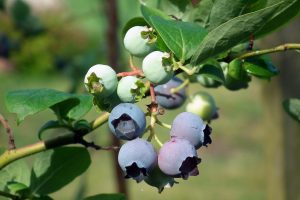
There are, of course, some plants which provide more than one type of food that sustains wildlife.
A great example is the woody shrub Highbush Blueberry, a common species growing in freshwater wetlands throughout Long Island. Its bell-shape flowers produce nectar consumed by many species of bees and butterflies; its pollen is eaten by some bees and other insects; the tasty berries are eaten by a variety of birds and small mammals (and, of course, a large mammal with two legs with whom you may be familiar if you like blueberry muffins or pies); and the leaves sustain caterpillars of many moths and butterflies including a wonderful group of small butterflies which includes the hairstreaks and elfins). So Highbush Blueberry is a “go-to” plant in moving your yard from paucity to productivity.
Another woody shrub to consider is elderberry which produces flat-topped berry clusters relished by birds. I enjoy watching the mockingbirds and catbirds each summer visit the ripened berry clusters of several elderberry bushes I’ve planted in the backyard.
Others shrubs to think about (and there are still others) include Spicebush, which is used by the beautiful Spicebush swallowtail butterfly as a food source while a caterpillar; and shadbush and chokeberry, both of which produce berries eaten by quite a few bird and small mammal species. If your property has moister soils think about planting Sweet Pepperbush, also known as Summersweet due to the strong and distinctive odors the plant gives off in summer. Many insects are attracted to these odiferous blossoms. Lastly, two other native “woodies” you might to consider for wetter soils are Steeplebush, also known as Spirea and Swamp Rose.
Trees
Speaking of woody plants, a number of tree species provide benefits to wildlife. Oaks, willows, hickories, cherries, beech, birch, dogwood, and sassafras are all especially valuable. Oak leaves, for example, are known to support hundreds of different kinds of caterpillars which are eaten by dozens of bird species. And bright red sassafras berries are consumed by a host of birds including cedar waxwings, catbirds, and several thrush species.
Wildflowers and grasses
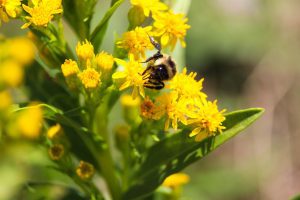
You can also affect positive change with non-woody plants such as wildflowers and grasses. Two excellent groups of plants that pollinators love are goldenrods and asters. Goldenrods (what a wonderful and evocative common name!) produce copious amounts of nectar that many bees, beetles, and butterflies consume as well as the plants’ pollen. (By the way — it’s not goldenrod pollen that causes hay fever — their pollen grains are too big — but rather ragweed, blooming at the same time, which has much smaller pollen grains since they are wind pollinated.)
Standing on the edge of a thick stand of goldenrod in bloom in late summer is to visit the busiest insect airport imaginable — dozens of bees, wasps, flies, beetles, and butterflies probing the countless flowers for nectar and pollen. Many moth and butterflies, as caterpillars, feed on goldenrod leaves. Several dozen goldenrod species are native to Long Island so there’s a lot of variety to choose from. Why not plant some “sunshine concentrate” in your flower beds?
Asters, too, are important wildflowers for wildlife providing nectar. Like goldenrods, they are beautiful, adding bright splashes of color to your yard such as the stunning purple rays of New England Aster. Several aster species are available for sale.
Milkweeds
Many other native species can become part of your local ecosystem. Milkweeds are another group, perhaps most well-known because Common Milkweed is the common host plant for the Monarch Butterfly, a species that’s the focus of a great deal of conservation concern due to their declining numbers (although in 2021 there appears to be a slight uptick in their numbers).
Besides Common Milkweed you should think about planting Swamp Milkweed if you have wetter, richer soils and Butterflyweed, a bright orange member of the milkweed family. Many species of insects are attracted to the nectar produced by these species and Monarch caterpillars can successfully grow eating Butterfly Weed leaves as the five caterpillars that came from a small flower garden by my back door can attest.
Other native wildflowers that sustain wildlife include, but are not limited to, Joe-pye weed, Boneset, Thoroughwort, Northern Blazing Stars, Bush Clovers, Mountain Mint, and Beggars Ticks.
To attract Ruby-throated Hummingbirds you need to plant red flowers — three good ones are Cardinal Flower (a stunner)!, Wild Bergamot (also known as Oswego Tea) and Trumpet Vine.
There’s value in planting a number of the same plants together, forming clumps rather than single plants. Some beetles don’t fly as well as other insects so its worth clumping together some natives to assist them. And odors and chemicals given off by groups of the same species are much stronger than scents given by individual plants so more is better!
—————————————-
If want to do more to make your yard wildlife friendly here’s a few other ideas:
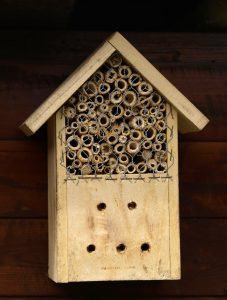
Build bee hotels. Many bees, wasps, and other pollinating insects can benefit from “bee hotels” placed around your property. A great project is to engage your children in researching, constructing and installing small bee hotels suitable to your property. These hotels will help some of the several hundred native bee species like mason bees which, unlike the European honeybee, nest solitarily. There’s many different designs you can find on-line such as drilling holes of various diameters into a several foot long segment of a “4 by 4”. Tying together a bunch of hollow bamboo stalks into a wood frame that hangs is an alternative design.
Can your Spray Can! It is tempting to turn to the easy fix of chemicals to control garden pests. The problem is these chemicals work too well; remember pesticides, herbicides, and other “cides” are all poisons, some of which have broad and deadly impacts to a large number of species. Research other, more benign options for controlling unwanted species — by doing so you allow the wanted species to flourish. Turn away from poisons.
Leave the Leaves and Save the Stubble! Layers of fallen leaves and standing stem stubble in your garden beds and throughout your yard sustain many species, especially insects that overwinter under leaves and in hollow stems.
Frog Logs to the Rescue! If you have an in-ground pool you may want to buy frog logs or ramps to allow animals like chipmunks a chance to escape. The “logs” are semi-circle floats in which a fabric ramp connects the float with the anchor portion filled with sand.
If you put away the poisons, invest in some frog logs if needed, retain leaves in flower beds and in the corners of your yard and, most importantly, plant native species to nourish pollinators and many other species of wildlife, your yard will become part of the living fabric of the larger world surrounding you. It’s axiomatic!
A resident of Setauket, author John Turner is conservation chair of the Four Harbors Audubon Society, author of “Exploring the Other Island: A Seasonal Nature Guide to Long Island” and president of Alula Birding & Natural History Tours and pens a monthly column for TBR News Media titled Nature Matters.
*This article originally appeared in TBR News Media’s Summer Times supplement on June 24.
By Daniel Dunaief
The Galapagos Islands, the Great Barrier Reef, Little Cayman and … Shinnecock Bay? Yes, that’s correct, the 40 square kilometer bay located on the southern end of Long Island recently joined a distinguished list of celebrated marine locations identified by Mission Blue, a non-profit international organization led by famed marine biologist Sylvia Earle.
Mission Blue named Shinnecock Bay a Hope Spot, one of 132 such locations in the world that it considers critical to the health of the ocean.
Shinnecock Bay has the distinction of being the only Hope Spot in New York State, the only one near a major city and one of three on the Eastern Seaboard.
“The idea that you could have a Hope Spot so close to a major metropolitan area is pretty significant,” said Ellen Pikitch, Endowed Professor of Ocean Conservation Science at Stony Brook University and the School of Marine and Atmospheric Sciences and Director of the Institute for Ocean Conservation Science.
The designation by Mission Blue not only puts Shinnecock Bay in elite environmental company, but it also completes a comeback story driven by scientists, their students, numerous volunteers, and other supportive groups.
“The point of Mission Blue designating this place a Hope Spot isn’t only to bring more people and attention to Shinnecock Bay,” said Pikitch, but is also to “send the message of hope that we can turn things around.”
Pikitch, Christopher Gobler, Endowed Chair of Coastal Ecology and Conservation at the School of Marine and Atmospheric Sciences, and Bradley Peterson, Associate Professor at Somas, led the efforts at the bay.
The scientists created clam sanctuaries in the Western Shinnecock Bay with strict no take rules for people, which helped jump start the restoration. The clams helped meet natural filtration goals.
The researchers also helped restore eelgrass, also called seagrass, which is a more effective natural way to sequester carbon per square inch than the rainforest.
Between 1930 and the start of the project in 2012, New York State had lost about 90 percent of its eelgrass. A task force projected that eelgrass would be extinct in the Empire State by 2030. The bay now has about 100 more acres of eelgrass than it had in 2012.
These efforts have created a “huge leap in the number of forage fish” including bay anchovies and menhaden, said Pikitch, who studies forage fish. “The bay is in a much healthier place now that it was when we started,” she added.
Tough beginnings
Indeed, in 2012, parts or all of the bay had to close because of brown or red tides. The tides sometimes “looked like coffee spilled across the entire bay,” Pikitch said.
The steps the researchers took to improve water quality took some time. “Harmful algal blooms didn’t disappear right away,” Pikitch said. “As the study progressed, the amount of time brown tides occurred got shorter and shorter. Ultimately we stopped seeing brown tides several years ago.”
Red tides, which can cause paralytic shellfish poisoning that could be fatal to people, had also been a problem in Shinnecock Bay. Nearly half the bay was closed to shellfishing in 2011, 2014, and 2015. In 2017 and 2028, about 1/4 of the bay was closed due to red tides. Since 2019, however, red tides haven’t threatened the bay.
On the water
Throughout the restoration process, scientists in training and volunteers contributed to various efforts. Konstantine Rountos, Associate Professor of Biology at St. Joseph’s University in New York, earned his Master’s and PhD and conducted his post doctoral research at Stony Brook University. He also served as the lead research scientist for the Shinnecock Bay Restoration Program trawl survey from 2012 to 2016.
Rountos called the designation “remarkable and extremely exciting.” When he started working on the bay in 2005 as a Master’s candidate, he saw stressors such as eelgrass declines.
“Not only was the ecosystem showing signs of collapse (decreased seagrass, decreased hard clams, increased harmful algal blooms), but the Bay was supporting fewer and fewer baymen,” he said. The Long Island “cultural identity of ‘living off the bay’ was in serious danger.”
Rountos believes people often overlook the significant ecological importance of this area, driving past these environmental and ecological treasures without appreciating their importance.
Amid his many Bay memories, he recalls catching a seven-foot long roughtail stingray. “It was very surprising to pull that up by hand in our trawl net,” he said.
A veteran of the bay since 2016, Maria Grima spent time on Shinnecok as an undergraduate at Stony Brook and more recently for her Master’s training, which she hopes to complete this August.
Grima has been studying the invasive European green crab that shreds eelgrass and consumes shellfish such as clams, oysters and mussels. In a preliminary analysis, the population of this crab has declined. Grima noted that it’s difficult to prove cause and effect for the reduction in the number of these crabs.
Rather than pursue a potential career in medicine, which was her initial focus when she arrived at Stony Brook, Grima decided to focus on “fixing the environmental issues that cause human health problems.”
She is “really proud that Shinnecock Bay” achieved the Hope Spot designation.
One of her favorite Bay memories involves seeing an ocean sunfish, which is a distinctive and large fish that propels itself through water with its dorsal and ventral fins and is the world’s largest bony fish. Seeing the biodiversity on a bay that has had historically poor water quality “gives you hope when you’re on the boat,” Grima said.
When friends and volunteers have joined her on the Bay, she has delighted in watching them interact with seahorses, which “wrap their little tail around your finger.”
Looking toward the future
While Pikitch is pleased with the designation, she said the work of maintaining it continues.
“We can’t rest on our laurels,” she said. “Continued construction on Long Island’s East End and the growing threat of climate change may require additional restoration work. We need to keep a close eye on what is happening in Shinnecock Bay and be ready to take action if necessary.”
